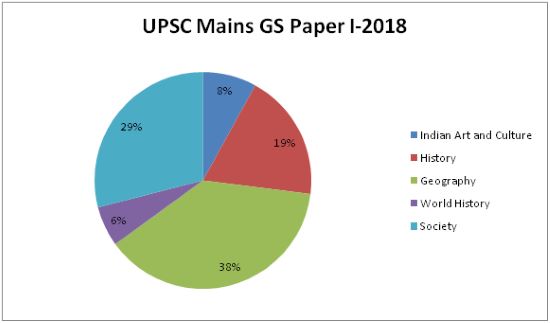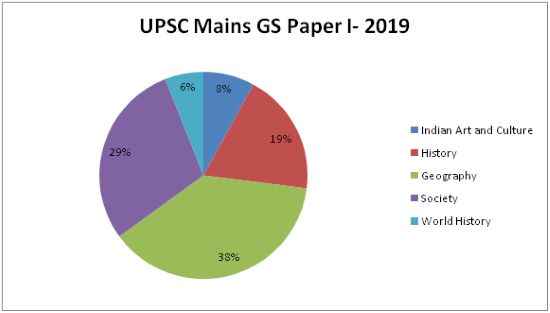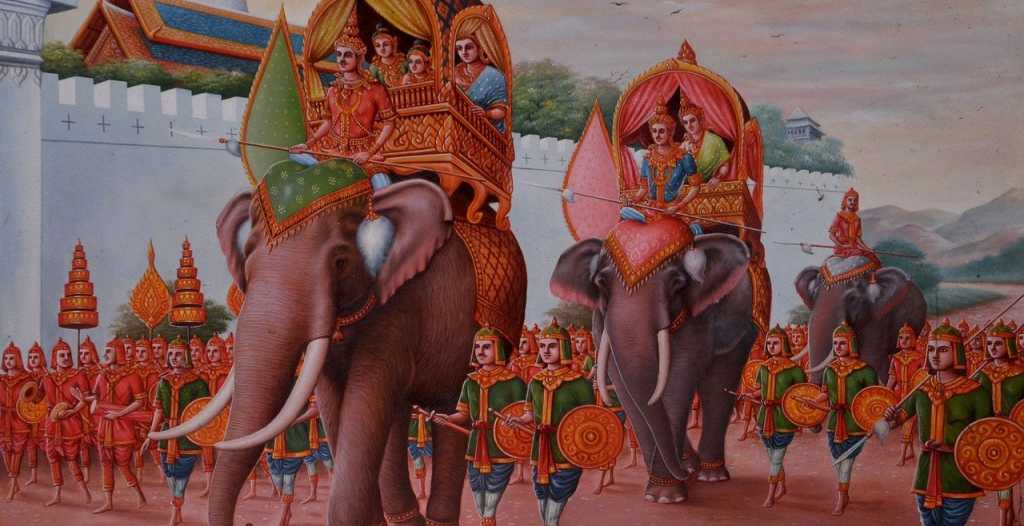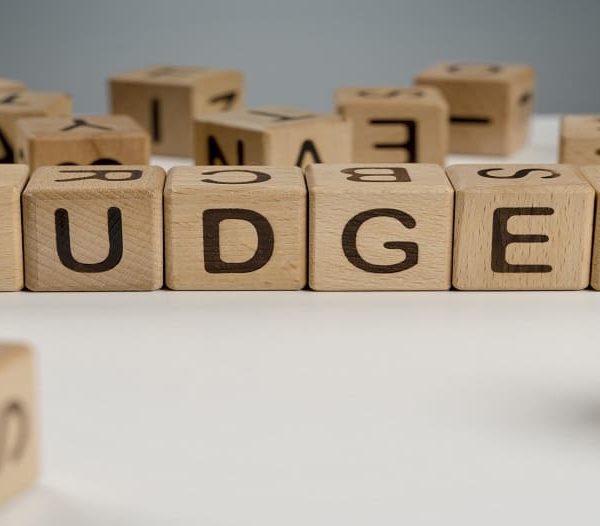Are you a UPSC aspirant? Well, you probably know that UPSC is one of the toughest examinations in India. It has three phases: Preliminary, Mains and Interview. The syllabus for UPSC is cast and covers almost every aspect of life and subjects.
UPSC Mains includes nine papers. General studies paper 1 is one of them. This paper tests history, world history, Indian culture, Indian society, etc. Here is a note of the topic of characteristics of Indian society.
Indian Society: Relevance to UPSC Mains
Indian Society and salient features of the Indian society diversity of India are an important part of General Studies Paper I of mains. Moreover, questions also come in Preliminary examination.
Trend of General Studies Paper 1
Here is the analysis of the previous year paper


Also Read: RoDTEP Scheme UPSC Notes: All Points Covered for 2021 UPSC Exams
Society: Meaning and Definition
Man is a social animal by nature and has to live in a society to fulfil his needs and desires. Aman is gregarious, reproductive, masters linguistic skills and has needs. To fulfil them he is forced to live together. This chain of networks consequently gave birth to society or the social system.
So we can conclude that society is an organization where individuals live together to fulfil their common objective.
“Society includes every willed relationship of man to man.”
– MacIver
“The term society means harmonious or at least peaceful relationship.”
–Dr. Jenks
“Society is the whole sum of voluntary bodies or associations constituted in the nation with all their various purposes and with all their institutions.”
– Barker
Elements of Society
As per sociologists, a society can be defined as a group of people who have interactions within a common territory, and share a similar culture.
We will now break down the keywords – social group, territory, interaction and culture for better understanding.
Social Group
It is the coming together of two or more people who interact and further identify with one another.
Territory
Every Country owns formal boundaries and territory (areas) that the world recognizes as belonging to the respective country. But, a society’s boundaries don’t necessarily have to be only geopolitical borders.
Interaction
The members of any society must come in contact with each other. If one group of individuals within a country will have no regular contact with another group, those groups cannot be considered part of the same society.
Language barriers and Geographic distance separate societies within a country.
Culture
People belonging to the same society will share aspects of their culture, such as language and beliefs. Culture is the values, language, beliefs, behaviour, and material objects that make up their way of life. It is a defining element of any society.
Also Read: What is the Delimitation Commission? UPSC Notes for GS Paper 2
Features of Society
# Society is a product of vast and complex relationships between humans.
# Society implies continuous integration and mutual cooperation among its members.
# Each member is interdependent of the other in society.
# It is abstract. This means we cannot see it but it is present.
# A society is dynamic and continuously changing its features.
# Every society has its own unique culture, habits, tradition, beliefs, value system, etc.
Also Read: National AYUSH Mission: Important Topic for UPSC GS Paper III Notes
Indian Society: An Introduction
India is a vast country withholding a huge population. It is also known as Subcontinent because, it has ocean, sea, mountains, plateau, plains, hill, desert, It has all the features of a continent yet it is not bi enough to be a continent. Therefore it is called Subcontinent.
Indian society is a perfect example of diversity in almost every dimension of social life. Whether it is religion, language, economic, regional, class, or caste. There is difference everywhere yet we stand united as an integrated nation. This diversity is found from the first civilization to the present one.
Indian Diversity deems fit with the saying accommodation without assimilation. This simply means that India has a space for each identity without breaking the nation’s integrity. India always has welcomed different cultures and people and dissolved them in its bi heart. From Aryan to European you can find different influences in Indian culture.
India owes its Unity in Diversity to its Constitution. The Indian Constitution values each separate identity and maintains the integrity of the nation. The Constitution of India is the supreme law of the land. It is formed under the motto of
“Of the people, for the people and by the people.”
It rests on the principle of unity in diversity. To understand Indian society we first have to understand Indian Constitution. Therefore let’s overview it and also describe any five salient features of the constitution of India.
Also Read: What is Sedition Law in India? Important Notes for UPSC
Indian Constitution: Brief Overview
Indian Constitution is the supreme law of India. It demarcates political function, power and duties of government. It also lays out fundamental political code, basic political structure, fundamental rights, directive principles and fundamental duties. And thus Indian Constitution becomes the lengthiest constitution of India.
“I feel it is workable, it is flexible and it is strong to hold the country together both in peacetime and in wartime. Indeed if I may say so, if thins o worn under the Constitution, the reason will not be that we had a bad constitution, what we will have to say is that man was vile.”
–BR Ambedkar in his speech about Constitution in Constituent Assembly.
On 26 November 1949, it was adopted by the Indian Constituent Assembly but only became effective on 26 January 1950 (also known as Republic Day) To draft, debate, and enact the Constitution took around 2 years 11 months 18 days. It has 35 articles, divided into 22 parts, 12 schedules, and 101 constitutional amendments.
Salient Features of Indian Constitution
# Preamble
# Lengthiest
# Self-made an Enacted Constitution
# Federal Structure and Unitary spirit
# Parliamentary form of government
Other features are Fundamental Rights, Directive Principles, Bi-cameral union parliament, universal adult suffrage, single citizenship, integrated judiciary, etc.
Also Read: Polar Vortex: National Atlas and Thematic Mapping Organisation Notes for UPSC
What are the Salient Features of Indian Society?
India is a big country with a long history. It is a perfect blend of purity and a mixture of foreign influences. Here is a famous quote by Jawaharlal Nehru in the Discovery of India on Indian society
“is like some ancient palimpsest on which layer upon layer of thought and reverie had been inscribed, and yet no succeeding layer had completely hidden or erased what had been written previously”.
Here are Basic Features of Indian Society
Diversity in India
Indian society is a synthesis of different cultures, regions, languages and beliefs system. It is plural by nature yet upholds its unity and maintains its cohesiveness as a united nation. There is so many differences are present in Indian society that you can find change in the living style and language for every 200 km.
In India, diversity doesn’t mean inequalities but differences and uniqueness. Indian is a diverse country. It is present in different levels:
# Geographical Diversity
# Climate Diversity
# Racial Diversity
# Social Diversity
# Cultural Diversity
# religious Diversity
# Political Diversity
# Linguistic Diversity
Multi-Ethnic Society
Indian society is multi-ethnic in nature. This implies the presence of different racial groups. Ethnicity is a category of those who are similar to each other in terms of language, dialect, history, culture, nation, etc. India is a home of different ethnicity.
#1. Ethno-racial
#2. Ethno-linguistic
#3. Ethno-national
#4. Ethno-religious
#5. Ethno-regional
Multilingual Society
Indian Constitution recognizes 22 languages officially. But to be precise more than 1600 languages are spoken in India. There are different languages present in India and hence we can say it is a multilingual society. These languages owe their origin to different ethnicities such as Indo-European, Dravidian, Austro-Asiatic, Tibeto-Burmese and Semi to-Hamitic families.
Religious Pluralism
India has different religions present in its society. This includes Hinduism and minority Islam, Sikhism, Christianity, Buddhism, Jainism, Zoroastrianism, Judaism, Bahá’í Faith, Persian, etc. Hinduism is the major religion of it while Sikh, Islam, Buddhism, Jainism belongs to a minority group. Moreover, Hinduism is further divided into other sects and subsects, for instance, Vedic religion, puranic Hinduism, Sanatan dharma, Vaishnavism, Shaivism, etc.
Kinship
Kinship is a bond or relationship that is either blood relation, marriage or adoption. A man is social by nature and therefore there are several complexities present in it. He’s surrounded by different relationships. Some relationships are inherited by birth and some afterwards.
Types of Kinship
There are two types of Kinship:
# Affinal Kinship: Affinal Kinship is a relationship that takes place as soon as two people are tied in marriage. Marriage is not only a relation between two people but two families. This includes ties like husband, wife, and other in-laws.
# Consanguineous Kinship: This relation is inherited by birth. This includes blood-relation such as children, brother, uncle, nephew, etc.
Primary Kins |
Direct relation such as Father, Mother, Husband, Wife, Son, Daughter, Brother And Sister |
Secondary Kins |
Uncle, Aunt, Cousins, Maternal grandparents, and Paternal grandparents |
Tertiary Kins |
In-laws such as Brother-in-law, Sister-in-law, etc |
Family
Family is the smallest and basic unit of a social organization. They have an important role in every individual’s life.
Different elements of a family are:
# It is formed by different relationships of husband, wife, father, mother, sister, brother, and many others.
# The family is responsible to bring up their children and fulfil their needs.
# Family is bond together with love, a sense of togetherness, and security.
# There are different sizes of families such as joint-family and nuclear families.
# They instil social norms and customs in the children.
# A family is attached aby love, respect and care.
Nature of Residence
Patrilocal |
Bride goes to groom’s house |
Matrilocal |
Grooms resides at bride’s house |
Neolocal |
Bot bride and groom live in a different house |
Nature of Authority
Patriarchal |
The Head of the family is the father |
Matriarchal |
The Head of the family is the mother |
Family Size
| Nuclear Family | Small family including husband, wife, children |
| Joint Family | Two or more generation stays in a house |
Marriage
Marriage is an important relationship that binds a man and a woman together for a lifetime. It is the base relationship of a family. This social institution fulfils the basic needs of a man and woman for instance, social, physical, cultural, emotional, etc. In India marriage is seen as the purest relationship and a tie that God himself makes. According to Vedic scripture, marriage is important for dharma, rati and praja. Dharma implies duties, rati sensual pleasure and praja means progeny.
Forms of Marriage
| Polygyny | One man marries more than one woman at the same time |
| Polyandry | One woman marries more than one man at the same time |
| Monogamy | One man marries one woman |
Rules and Provision of Marriage
In India, Marriage is not only a new relationship between two individuals but also two families. Therefore marriage related decision is taken by a family whole. Therefore there are some set rules:
Decision Based on Prohibition
#1. Endogamy: Life partners can be chosen from the same caste, race, tribe or village.
#2. Exogamy: An individual has to marry outside his group such:
# Gotra Exogamy
# Pravara Exogamy
# Village Exogamy
# Pinda Exogamy
Decision-based on Status
#1. Isogamy: Marriage among two different individuals of equal social status.
#2. Anisogamy: Marriage among two different individuals of different social statuses.
# Hypergamy (Anuloma): a woman marries a man of a higher caste or family.
# Hypogamy (Pratiloma): a woman marries a man from a lower caste or family.
Decision-based on Preferences
#1. Cross-cousin marriage: In this type of marriage a person is married to their paternal uncles or aunts son or daughter.
#2.Parallel Cousin marriage: Marriage between children of two sisters and brother.
#3. Levirate marriage: A woman marries her husband’s brother after his death.
#4. Sororate: A man marries his wife’s sister after the death of his wife’s death.
Class
In India, there are different classes present in society. This different class differs based on economic differences. This difference is based on education, property, business and work-related, etc. According to famous economist Karl Marx, Man is a class animal.
Caste
India has a different caste system present in its society. The word caste is a Portuguese word that means race or group. This caste system is the result of the varna system. According to Rigveda, the caste system was decided according to profession-based but later on, it evolved as a pre-decided system.
This is a famous sloka from Rig Veda,
| Brahmin | Kshatriya |
| Vaishya | Sudra |
Indian Constitution recognizes 4 different castes, is as follows:
| General | Obsessed Backward Community |
| Scheduled Caste | Scheduled Tribe |
Features of Caste System
# Caste systems are arranged according to the hierarchy system
# There are rules and prohibitions on different conduct of a caste such as eating, drinking, living, etc.
# A person acquires a caste from their birth.
# A person can only marry a person of their caste. Inter-caste marriages are prohibited and avoided.
# Restriction is imposed on people according to the caste system.
# Untouchability is practised in India. It is a practice of ostracizing a caste by discriminating against them based on caste. Lower caste people are considered untouchable and higher caste avoid touching them.
# According to the Constitution, lower or weaker castes are given reservations in the legislature, jobs, and even educational institutions.
Also Read: Fixed Term Employment in India: UPSC Notes on New Policies for Labour Laws in India
Tribes
A tribe is an Indian group that poses similar features and qualities that makes it different from other entities. They are tied together by customs, rituals, beliefs, kinship, social rank, political organization, etc. According to an official report, there are 705 Scheduled tribes in the country and they constitute around 6% of the total population of India.
Different Tribes
| Gonds Tribes | Bhils Tribes | Santhal Tribes | Great Andamanese Tribes | Khasi Tribes |
| Garo Tribes | Angami Tribes | Munda Tribes | Bhutia Tribes | Chenchu Tribes |
| Kodava Tribes | Toto Tribes | Irulas Tribes | Nyishi Tribes | Bodo Tribes |
| Warli Tribes | Toda Tribes | Kurumban Tribes | Soliga Tribes | Siddis Tribes |
Race
India is a mixture of different races. Indian population has all the major races of the world.
| Race | Region | Physical Appearance | Arrival |
| Negrito | Kadar, Andamanese, Angami Nagas, and Bagadi of Rajmahal hills | Short stature, broad nose, black skin, thick lips and woolly hairs | First to arrive in India |
| Proto-Australoid | Bhils, Mundas, Santhal, ho, Chenchus | Brown skin, short stature, broad nose and curly hair | Second to arrive in India |
| Mongoloid | # Paleo Mongoloid (Present in Nagas of Himalayan regions and northeast India)
# Tibeto-Mongoloid (Sikkim and Bhutan). |
Yellow skin, straight hair, prominent cheekbones, almond-shaped eyes. | Entered from Mongolia |
| Mediterranean | Entire Subcontinent | The brown complexion, medium nose, stature, and long, narrow head. | Mediterranean region |
| Western Brachycephals | # Alpinoid: North and Western India
# Dinaric: Bengal and Orissa # Armenoid: Parsis |
Western people with a broad face | Taiga and Baltic regions |
| Nordic | Punjab, Haryana, Jammu and Kashmir, and Uttrakhand | Medium stature, straight hairs, round face, prominent nose | Last to arrive |
Coexistence
The Indian society has survived in the face of diversity, thanks to its accommodative values of tolerance and mutual respect that have existed from the early times.
The multitude of invaders who made India their home led to the mixing and co-existence of many different cultures.
In ancient times, the Indus valley civilization was a secular society and traded peacefully with societies like Mesopotamia, importing their culture too.
Buddhism and Jainism promoted these values through ancient texts.
“Sarva-dharma-sam-bhava”
represents such secular values.
The co-existence of various philosophies including atheistic, religious and materialistic, symbolizes the society that must have existed in those times.
During the medieval period, the repeated invasions and trade led to the fusion of multiple cultures.
The mixing of Nagara and Dravidian styles into Vesara style, Arabic and Hindavi into Urdu, Bhakti and Sufi movements (Teachings of Kabir, Guru Nanak, Khwaja Chishti etc.), Dīn-i Ilāhī of Akbar are good examples of mutual respect.
Presence of Spirituality and Materialism
In Indian society both features of spirituality and materialism are present. Spiritualism is concerned with the human soul and it is a principle that aims to alleviate the human soul. It is a way to od. India is known as the centre of spirituality in the world.
On the other hand, Materialism values worldly goods and services. This philosophy advocates valuing the materialistic things of the world. This advocate accommodating luxury items.
In India, you will find both coexisting peacefully. Indian society strikes a perfect balance between them.
Also Read: Bal Swaraj Portal: UPSC Current Affairs Notes for Better Preparation
Values Individualism and Collectivism Both
Individualism holds the importance of individuals liberty and freedom. It firmly believes that an individual comes prior to a community. The whole community is the opposite of it which values community over the individual. In India, you will find both of them.
Rural and Agrarian
For more than half of the population of India, agriculture remains the sole source of livelihood. An estimated 70% of our population lives in rural territories.
Agrarian festivals celebrate the harvest of the crops and are celebrated in the form of Holi, Lohri, Pongal, Onam, Sankrant, etc.
Many rural art forms like Madhubani (Bihar), fabric weaves like Khadi, and handicrafts of bamboo are just as popular in the urban areas.
Co-existence of Traditionalism and Modernity
Globalization might have bought with it a surge of modern values and practices, but traditionalism is still prevalent and preserved in India. The traditions of Indian society have also made their way to the outside world through the same gates of globalization.
Let us see a few examples:
# Dance and music: Indian dance/music forms are equally popular as their western counterparts. Indo-western fusion has been a popular theme in performing arts.
# Gyms might have become an important part of the Indian lifestyle, but yoga has also attained celebrity status.
# Nuclear families have become common, but children still live with and take care of their parents in their old age.
# International cuisines and food habits are equally popular as local ones.
Also Read: Permanent Court of Arbitration: Important Notes for UPSC Exam
Syncretic and Dynamic
As mentioned earlier, our society promotes accommodation as well as assimilation.
Over the years, multiple tribes have lost their core indigenous culture due to assimilation into the major population of Indian society. Such contacts with different cultures also gave birth to newer practices. Society is dynamic as it is changing every day.
Assimilation examples–
#The number of PVTG (particularly vulnerable tribal groups) is increasing
#Many ethnic tribes like the Naga are struggling to protect their culture from the outside world.
Syncretism examples–
# Urdu comes from both Arabic and Hindavi
# The Rashtrapati Bhavan is an architectural splendour created from the fusion of European, Rajput and Mughal design.
# The Sufi movement and the Bhakti movement were complementary to each other.
Unity in Diversity
Indian society has challenged the scepticism of many political thinkers post-independence that were doubtful regarding India’s amalgamation as one nation amidst vast differences and big numbers of ethnic groups, languages, culture and diversity.
The core values in the constitution, the reorganization by the state on the basis of language as well as the efforts of the government to protect the interests of minorities has helped in keeping up this unity.
Example-
# Inter-state migration
# Mutual celebration of religious festivals despite religious differences
# Cosmopolitan culture in metros
Also Read: PM Matru Vandana Yojana for Women & Child Development: Here’re the Important Points for UPSC Notes
Conclusion
I hope that the above-mentioned information about the Indian education society has helped you to know how to cover salient features of Indian society as well as understanding the importance of knowing about the Indian Society for your UPSC examination.
Moreover for similar articles to aid your UPSC preparation visit UPSC Pathshala. This website offers you various courses, preparation material, high-quality videos, etc.
Good luck!
Also Read: Uniform Civil Code in India: Suggestions, Challenges and Essay for UPSC Notes







What a stuff of un-ambiguity and preserveness of valuable familiarity on the topic of unexpected emotions.
best material on indian society
Way cool, some valid points! I appreciate you making this article available, the rest of the site is also high quality. Have a fun.
thanks upsc pathsala for the explanation!
impressive
This is really an amazing blog on the most important topic. Do you have any confusion?
Thank you for providing the notes, it was very helpful and the information was detailed and making revision notes out of these was very easily done, what do you think about how to write revision notes?